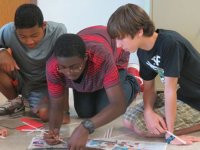Nurturing Collaboration: 5 Strategies
When collaboration goes wrong, it can be toxic for learning and classroom culture. We are all familiar with the scene: a group of students that is supposed to be completing a collaborative project has splintered off into dysfunctional factions. Maybe it's one student who has sullenly separated her- or himself from the rest of the group, or maybe the group has become two non-communicative teams with separate visions. Sometimes these conflicts lead to resentments that have the potential for long-term damage to the classroom community.
In my previous post, I wrote about the power and potential of collaborative projects and peer feedback. These opportunities work to democratize the classroom and provide opportunities for learning on multiple levels.
Facilitating collaboration is one of the many aspects of teaching that requires skillful planning, a high degree of awareness, and on-the-fly decision making. Of course, even with the best preparation, the messiness of learning and the fact that we are all humans will cause unforeseen challenges to emerge!
Below are five strategies that can help nurture successful collaborations.
1. Model Feedback
On the days when my students have come to class with a draft of a project that's ready for feedback, I'll reach out to a couple of students on the side before class starts. I then start class by calling on these students who have consented to share parts of their project. After each excerpt, I ask the class what they notice or what stands out. These affirmations set a tone for appreciating each other's work. After we have a list on the board of pluses (+), I then ask the class if they have questions (?) for the author. Asking for multiple questions instead of critiques helps me to reinforce the idea that, as authors and creators, it's important to solicit feedback and that everyone has the right to decide which feedback is most helpful for them.
2. Be Aware!
The talented nonviolence trainer George Lakey, author of Facilitating Group Learning, first introduced me to the idea of "internal weather" within individuals who are part of a group process. When I have groups working on a larger project, I maintain a constant awareness of the dynamics and the physical language of individuals around the room, even when I am far away from a group. I make mental notes about which groups are communicating effectively and which groups are dominated by one or two individuals. I take note of who is sitting separately from other group members. I often have groups work on Google Docs that are shared with me and color coded to represent the contributions of different students. A quick glance at a doc can give me a sense of a group's status.
3. Provide a Clear Structure
When students are giving each other feedback on a draft or collaborating on a larger project, I always provide clear structure and expectations. I may tell them, "You need to insert four comments on your partner's doc -- two things that are working well and two questions that will help the author to improve the piece." I recently gave students a peer review sheet asking them to give feedback on:
- Four things that are working well
- Three specific ideas for improvement
- Two specific questions for the author
- One source that you recommend for the author
4. Use Tech Tools to Simplify the Process
If technology is available, the right tool can simplify collaboration and give students easy access to the work of their peers. That said, inappropriate tech choices can stop a project in its tracks. Google Docs, wikis and blog posts all have the potential to give students access to each other's work. Audio and video projects are often edited on one machine. In these situations, I strategize -- or have groups strategize -- different roles that can contribute to the final product.
5. Be Ready to Provide a Jump Start
Even with careful planning, collaboration can go really wrong -- really quickly! In these moments, I am quick to step in and provide help for a dysfunctional group in finding a way to move forward. This may mean facilitating a conversation about delegating tasks, conflict resolution, providing tips or sources for research, or offering affirmations and helping to establish a positive tone within a group.
I am constantly in awe of the different ways that my students, who come from so many different backgrounds, deeply engage with one another. Whether they are debating an issue, editing a podcast or planning a skit, these young people regularly teach me about the many ways it is possible to learn from and create with those around us.
In what different ways do you facilitate and nurture collaboration?
